Plants with orange flowers
There’s a wonderful warmth that plants with orange flowers can bring to the garden, often more subtle that bright pinks and reds and less cool in tone than yellows. But if subtle isn’t what you are looking for, there are some strong, bold orange flowers that can add striking notes to the scene.
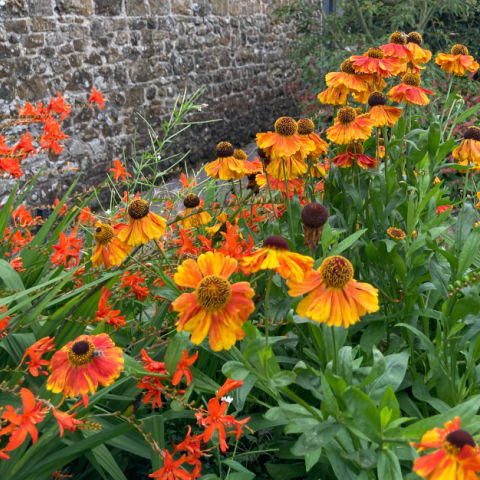
Team orange flowers with purple, true blue flowers or hot pink to make both the colours pop. Or group with apricot, yellow and cream for a more blended, restful result.
In this article, links are provided to help you purchase the plants for your own garden. I’m aware that some readers prefer not to purchase via Amazon. So wherever possible, I’ve included links to other businesses, and in brackets you’ll find links to the plants on Amazon.
Calendula officinalis

Common or pot marigold is one of the easiest to grow plants. Scatter Calendula officinalis seeds where you want them to grow and within a few months, they will be flowering. Usually grown as an annual, they are hardy throughout most of UK and Ireland. (If you shop via Amazon, here are the seeds for Calendula officinalis) They self-seed freely and seedlings can be transplanted. Available in a range of flower forms and colours, the common or pot marigold has a simple daisy-like flower. Grow in full sun or partial shade on any soil, except heavy clay. They are drought-resistant and will fail to thrive in constantly wet soils. The petals are edible and can be dried and used as an alternative to saffron.
Eremurus ‘Cleopatra’
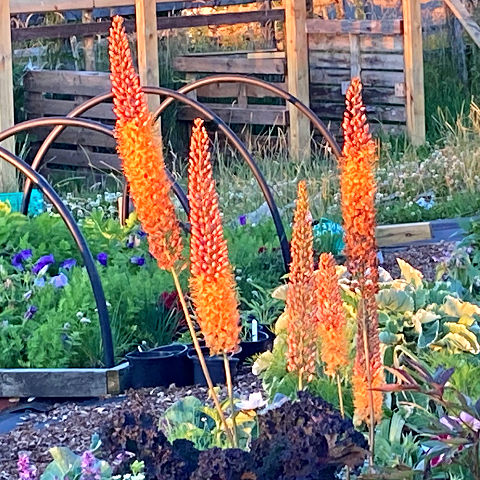
I grew several different fox-tail lily a couple of years ago. ‘Cleopatra’ is not as tall as many Eremurus, so is ideal for more exposed gardens. From the curious-looking starfish shaped tuber, strap-like leaves grow and a tall flower spike, 100cm – 150cm tall. Grow in well-drained soil of any kind except clay, in full sun in a sheltered spot. Hardy in UK and Ireland. In my north-facing, very wet and windy garden, this perennial plant gave a good display in the early summer, but failed to live through the winter. Next time, I’ll grow it in a raised bed for improved drainage and to protect it from sitting in water during the winter months. (Find Eremurus Cleopatra on Amazon)
Bomarea caldasii
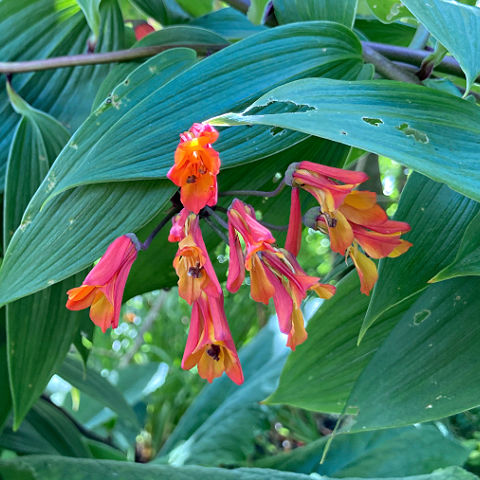
Here’s an interesting climbing plant for a warm spot in the garden. The trailing lily is a herbaceous climber that twines around and scrambles through other plants to a height of 300cm. Bomarea caldasii requires moist, but well-drained loam or sandy soil. Grow in full sun in a south- or west-facing, sheltered spot. Although it will tolerate cool temperatures, it will not survive being frozen. Cut back dead stems at soil level in autumn and move to a frost-free position before the first frosts. (Find Bomarea on Amazon)
Leonotis nepetifolia
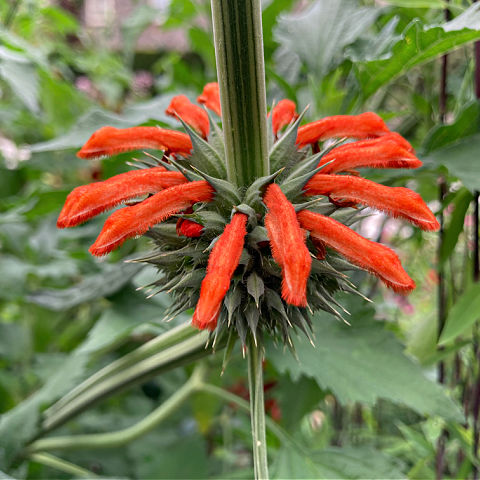
Commonly known as Lion’s tooth, this semi-evergreen shrub can grow to 200cm height and 100cm – 150cm spread. Grow in all soil types except acid or clay, in full sun in a sheltered spot. Leonotis nepetifolia is best grown as a tender perennial and move to a free-free environment before the first frosts. Leonotis nepetifolia comes from South Africa. These plants with orange flowers have become a nuisance in some sub-tropical areas of the world and now is considered invasive in Australia, Hawaii, and Florida. However, in the UK, it is currently unlikely to become a nuisance. Because, although tolerant of cool temperatures, it won’t survive freezing.
Geum ‘Totally Tangerine’
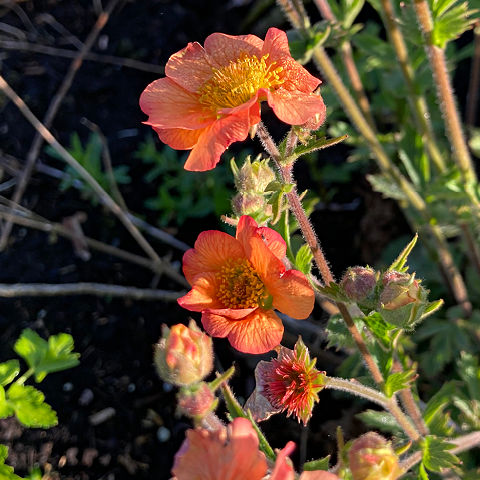
For a soft peachy-orange, Geum ‘Totally Tangerine’ has a lot going for it. The flowers sit above a mound of mid-dark green foliage and it flowers over a long period from spring to autumn. In my north-facing, hillside garden it has even flowered through the winter! Height 90cm and spread 50cm. Deadhead regularly to prolong the flowering and cut back the flower stalks or the plant ends up looking very spiky. If you miss deadheading, you can cut the plant back hard during mid to late summer, for a new flush of leaves and flowers in autumn. It is unfussy about soil and situation and is fully hardy throughout UK and Ireland. The seeds are sterile, so propagate by division. (Geum Totally Tangerine on Amazon)
Hedychium ‘Tara’
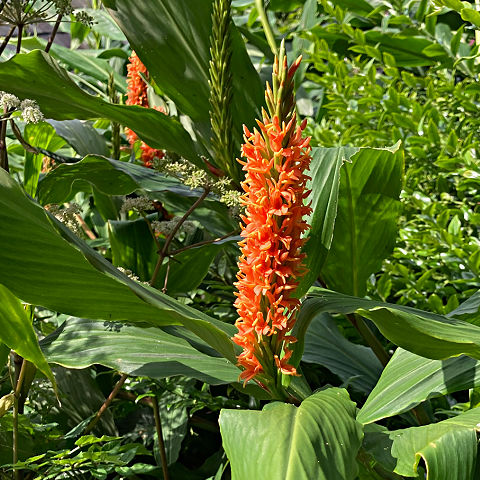
Ginger lily ‘Tara’ is a clump forming variety that can reach up to 200cm in height. It is hardy throughout most of the UK and Ireland, but give it a deep mulch in autumn. To be certain that it survives the winter, it can be grown in pot and moved to a frost-free environment. Grow in full sun or partial shade in a sheltered spot in a south- or east-facing position. Hedychium ‘Tara’ prefers soil that is not clay, and is moist, but well-draining. During summer and autumn, the flower spikes add dramatic vertical accents with the added bonus of fragrant flowers. If you want a tropical look in your garden, this would be a great addition.
Helenium ‘Mardi Gras’ (‘Helbro’)
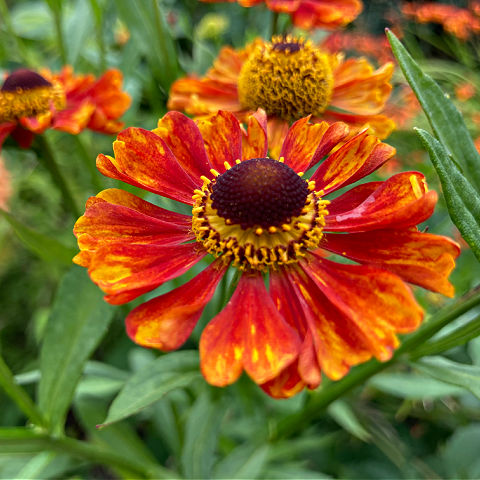
Helenium flowers from mid-summer to mid-autumn with a riot of bright daisy-like flowers that have a red, orange and yellow petals around a dark centre. A clump forming herbaceous perennial that grows to 75cm height and spread. Unfussy about soil type or situation, although it may struggle a bit with a north-facing site. It is hardy throughout UK and Ireland, even during the most severe winters. I think Helenium ‘Mardi Gras’ is worth considering for its ease of growth and hardiness and the mass of flowers. Deadhead regularly to prolong the flowering period. (On Amazon, find Helenium Mardi Gras)
Scrophularia grandiflora
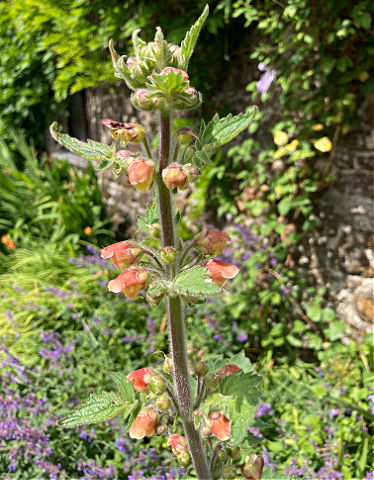
These unusual, yet easy to grow perennial plants with orange flowers. Portuguese figwort is similar to common figwort, it has square stems and wasps pollinate the flowers. However, this plant has yellow and orange flowers, which are good as a cut flower. Sow seeds in early spring indoors, or direct sow late spring. Flowers through the summer.
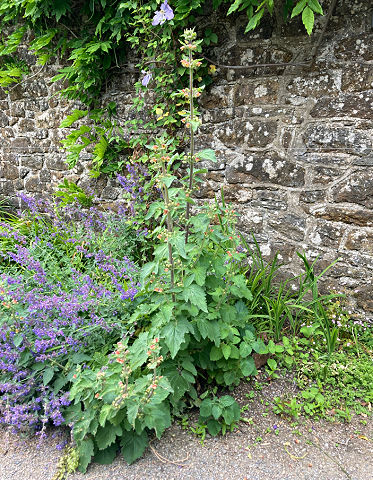
Confusingly seed sellers suggest a height range from 60cm to 180cm, and the plant I spotted at Aberglasney Gardens last summer was around 120cm tall.
Kniphofia uvaria
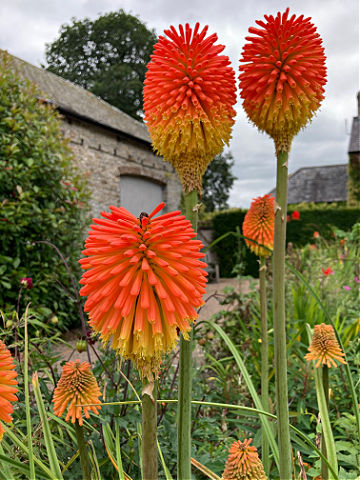
For many years, I didn’t like red hot pokers, but then a neighbour gave me a clump. Not wanting to seem ungrateful or rude, I planted it in the garden and I’m so glad that I did. My mind was changed completely, especially when I saw how much the flowers were visited by bees and other flying insects. They are available in a wide variety of colours, and there are some striking bright orange colours to add a vibrant splash in the border. Knifphofia uvaria is drought resistant and flowers during summer and autumn. The petals usually fade as the flowers die, but more of the tubular flowers open to keep the display lasting for weeks. Height 120cm and spread 100cm. Prefers loam and sandy soil in full sun in a south- or west-facing position. (Find Kniphofia on Amazon)
Ligularia dentata ‘Desdemona’
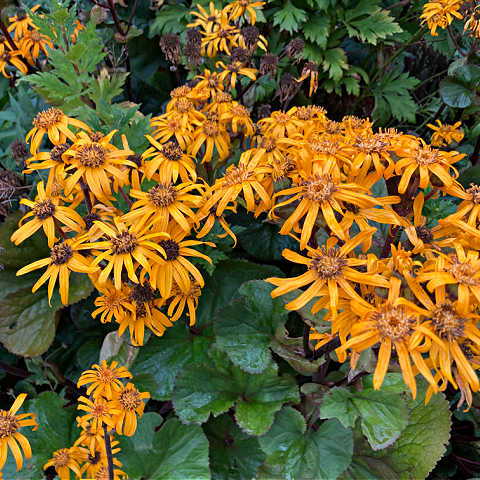
The leopard plant needs poorly-drained, clay or loamy soil to thrive. Grow in full sun in a south- or west-facing position in a sheltered spot. They are robust herbaceous perennials and not only are they plants with orange flowers, but the leaves provide interest with a bronze-tint and deep purple on the underside.
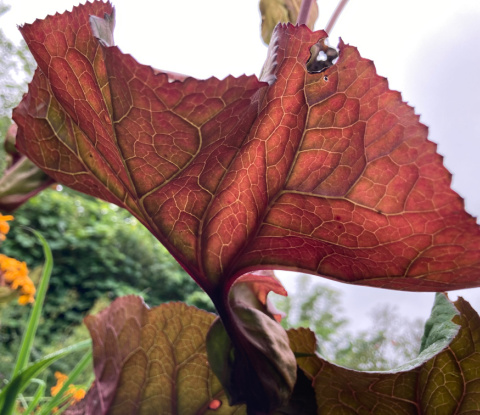
Ligularia dentata ‘Desdemona’ has 10cm orange daisy flowers that grow in clusters, making it eye-catching and worth the space in the garden. It flowers late summer to early autumn. Height 100cm. Propagate by division. (Or find the Ligularia dentata seeds on Amazon)
Tithonia rotundifolia ‘Torch’
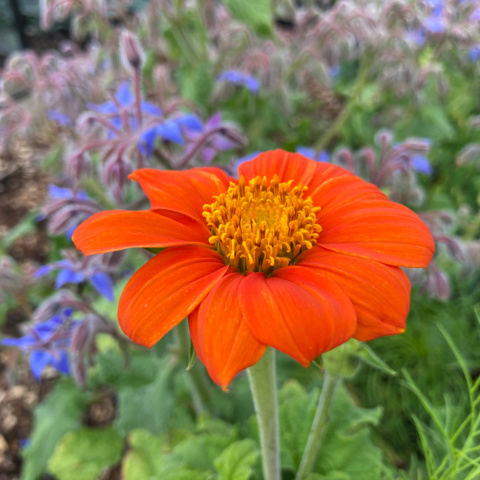
If you can provide the right conditions, Mexcian sunflower ‘Torch’ is well worth growing. The orange of the 7cm – 9cm flowers is one of the most intense I’ve seen in a flower and they stand out well against the foliage. Grown as an annual, Tithonia rotundifolia ‘Torch’ reaches 120cm height and 50cm spread. It needs loamy or sandy soil that is well-draining. Tithonia prefers full sun in a sheltered position in a west- or south-facing site. It will tolerate cool temperatures, but will die if frozen. I’ve tried growing it in the heavy soil on our windy north-facing hillside and although it did produce some flowers, it was obvious that it was not thriving. (If you shop on Amazon, Tithonia Torch)
Rosa ‘Precious Amber’ (F)
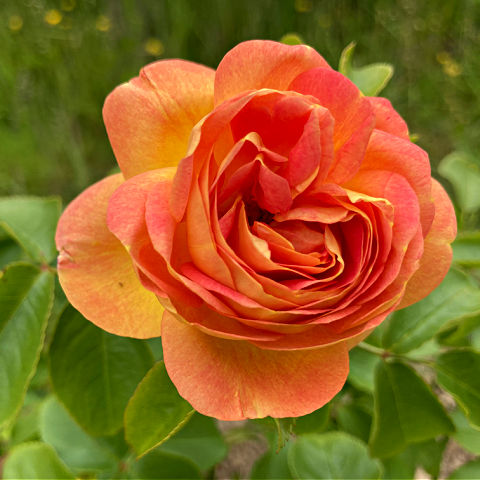
I grow this rose in the long shrubbery and every year I am surprised at the depth of colour of the flowers. It’s a compact rose that grows to height and spread of 75cm, with glossy leaves and lightly scented flowers. Grow Rosa ‘Precious Amber’ in full sun in a sheltered spot. It is repeat flowering throughout summer and autumn. This robust shrub is Hardy throughout the UK and Ireland even in severe winters. (If you shop via Amazon, Precious Amber rose)
Scadoxus multiflorus

More commonly known as Fireball Lily. Scadoxus multiflorus is not hardy, so will need frost free shelter during the cooler months The flower heads are 10cm to 25cm across and contain as many as 200 flowers. Each orange-red flower has very thin petals and long stamens. Grow is a south- or west-facing sheltered position in loamy soil or compost. Height 45cm.
More information
The article about flowers for Plants with Orange Flowers was written for Amateur Gardening magazine and published in May 2025. I may have updated some of the specific varieties and images and added further suggestions. Additionally, links are included to help you find the suggested plants and links to purchase via Amazon are included in brackets where available..
- Baby pepper inside pepper | Strange vegetable - September 16, 2025
- Biennials to sow in June and July - September 12, 2025
- Protected: Urban back garden - August 28, 2025
